Diet Plan for Weight Loss, Food & Nutrition, Health, Superfoods, Type 2 Diabetes Checklist
Diabetic Diet: A Guide To Manage Diabetes With Healthy Food
Medically reviewed by Spandana Nagulapally, Masters in Clinical Nutrition and Dietetics
A diabetes diet is one of the most searched questions! Do you know why? It is because of the increasing prevalence of this life-threatening metabolic disorder.
Diabetes is one of the most threatening disorders which is spreading at an alarming rate. In the last three decades, the prevalence of diabetes has increased many folds irrespective of the income levels of the nation.
According to the International Diabetes Federation, approximately 425 million adults (age between 20-79 years) are living with diabetes.
Moreover, 1 in 2 people with diabetes remains undiagnosed [1]. And, this number is expected to reach 629 million by 2045. Around 60 per cent of the diabetics is found in Asia.
79% of adults with diabetes were living in low- and middle-income countries: International Diabetes Federation
When diagnosed at an early stage, diabetes is easy to manage and control. The problem arises if this condition remains undiagnosed or untreated, as leads to several complications affecting your nervous system, heart, kidney, and even hands and legs.
Where the market is flooded with medications, attractive claims and supplements to control the blood sugar level. It is important to be well aware of the disease and its health management in the most natural way possible.
What is diabetes?
Diabetes is a chronic, metabolic disease characterised by elevated levels of blood glucose. It arises because the body is unable to produce enough insulin for its own needs, either because of impaired insulin secretion, impaired insulin action, or both.
The ancient Greeks coined the term ‘diabetes’, meaning excessive urination with dehydration, but neither they nor the Romans appreciated that the urine contained sugar; “diabetes” was considered a kidney disease until the 18th century.
Types of diabetes
There are mainly 3 types of diabetes.

-
Type 1 diabetes
This type of diabetes is also called juvenile diabetes mainly affecting children and adolescents. It is an auto-immune disease as the insulin-secreting cells are destroyed by self-body and thus, the body is unable to produce insulin.
Type I Diabetes affected people have to survive on daily doses of artificial insulin to regulate their blood glucose level.
-
Type 2 diabetes
It is the most common type of diabetes, accounting for more than 90% of total diabetes cases. It generally occurs in the middle age and older people.
Also known as Diabetes Mellitus, it affects the way the body uses and responds to insulin. Unlike Type I Diabetes, the body still produces insulin, your body cells do not respond as effectively as they do usually.
-
Gestational diabetes
This type of diabetes is associated with an abrupt rise in blood glucose level during the pregnancy phase, which causes complications to both the mother and the child.
Though this kind of diabetes is temporary and goes away with childbirth, it makes the mother more susceptible to high risk of developing type 2 diabetes in later life.
Prediabetes
Sometimes, people get confused between prediabetes and diabetes. Prediabetes is the early stage of diabetes, at which if diagnosed, prevents further complications of actual diabetes.
Also known as the ‘borderline diabetes’, prediabetes is characterised with a higher blood glucose level than normal but not high enough to be classified as diabetes.
What is insulin and its role in diabetes?
Insulin is a hormone that is produced by the pancreas and it enables the human body to use sugar (also referred to as glucose) from carbohydrates you get from your food.
Insulin maintains your sugar level and prevents it from spiking too high or going too low. Now according to our in-built mechanism, your cells need sugar for energy and sugars cannot go directly into most of your cells. Once a meal is consumed, the blood sugar rises and the pancreas releases insulin into the bloodstream.
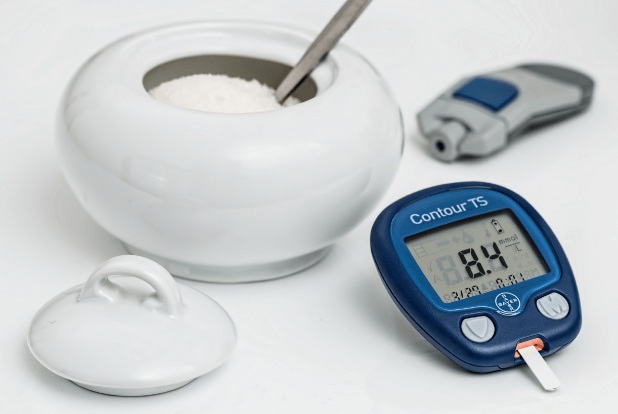
This insulin gets attached to the sugars and helps them enter the cells. In fact, insulin is the primary element that allows sugar to enter your cells and be used for bodily functions. If the body has excess sugar, the insulin stores in its liver use it when the body requires it.
So basically insulin is what helps your body to keep the sugar levels maintained. The problem occurs when your pancreas starts secreting more or less insulin than your body requires. If the insulin production is low, the sugars in your body won’t be consumed and this can lead to long term implications like diabetes.
Risk factors for diabetes
The risk factors may vary from manageable to unmodifiable factors. The better understanding of the risk factors helps in effective prevention of the causes and disorder along with its better management.
The risk factors can be categorised as:
1. Unmodifiable risk factors
- Family history
- Age
- Genetics
Such risk factors cannot be controlled and require proper medication and attention.
2. Modifiable risk factors
- Unhealthy eating habits
- Sedentary lifestyle
- High BMI or obesity
- Medical conditions like high blood pressure, cholesterol, PCOS or prediabetes.
Symptoms of diabetes
The symptoms are specific and its timely diagnosis helps in better management and treatment of the disorder. The symptoms include,
-
Frequently feeling thirsty
Are you feeling thirsty even after consuming a few glasses of water? It may be one of the signals that you should get your diabetes checked by your doctor.
What happens is in case of diabetes, our muscles and other tissues get dehydrated.
When the level of blood sugar rises, the body tries to pull the water in the muscles and tissues in order to dilute the sugar in the blood. This is what dehydrates the body and we start craving to drink more water.
-
Frequent feeling of urination
As a result of drinking excessive water, you feel the need to urinate more. The body also tries to get rid of excess sugar through urination.
So, if you feel that you are urinating more than normal, take it as a probable symptom of diabetes and see a doctor.
- Extreme pangs of hunger
Just like drinking, if you are feeling frequently hungry, even after just having eaten, you should see a doctor rule out diabetes.
This happens when your tissues don’t derive enough energy from the food that you have consumed.
-
Unexplained weight loss
If you have a normal diet and are still going on losing weight, you should give it a check since this normally happens with people having type 1 diabetes.
If the body doesn’t get enough energy from the food it is consuming, it breaks down other sources of energy like fats and proteins amongst others. This leads to obvious weight loss, which should be taken as a symptom of diabetes.
-
Fatigue
Sugar, as we all know, acts as the main energy provider to the body. In the case of diabetes, if the body is not able to convert the sugar into energy, we get a feeling of fatigue. This is a major symptom of diabetes.
-
Blurry vision
When the blood sugar goes abnormally high, it may lead to blurry vision. It happens because the fluid may have shifted into the eye duct. The problems normally resolve once the blood sugar level comes down.
According to the research conducted by the National Eye Institute (NEI), the leading cause of blindness in Americans is Diabetic Retinopathy. People with diabetes have higher chances of contracting cataracts and glaucoma.
-
Slow healing of infections and wounds
If you are suffering from type 2 diabetes, you may have a tough time healing your infections and wounds. This happens because of the fact that more bacteria survive when blood sugar is high.
High blood sugar negatively impacts the white blood cells, which are actually responsible for the healing of wounds. Due to this, cuts, wounds and infections take much longer to heal when your blood sugar is high.
-
Numbness in hands & feet
The high blood sugar can affect blood circulation and damage the body’s nerves. People with Type 2 diabetes often feel pain or numbness in hands and feet which can lead to nerve damage.
These diabetes symptoms may include deep, rapid breathing, nausea or vomiting, stomach pain, flushed complexion, confusion, fruity-smelling breath and in severe cases, it can lead to comatose.
In some chronic cases, the following complications may also develop kidney disease (nephropathy), eye disease (diabetic retinopathy), nerve damage (diabetic neuropathy), vessel damage, amputations, due to nerve and vessel damage, dental issues and skin issues.
Diagnosis of type 2 diabetes
Consulting a doctor on time can help you in diagnosing your diabetes on time. The doctor will test your sugar levels through a blood test.
In most cases, doctors will take a test in two days in order to confirm the disease. There are different types of tests for detecting sugar levels.
- Oral Glucose Test- This test basically checks sugar levels two hours before and after drinking a sugary drink. It is taken to see the body’s ability to handle sugar.
- Fasting Glucose Test- This test is taken on an empty stomach. One is not allowed to eat or drink anything before eight hours of taking the test.
- HbA1C- Also known as glycated haemoglobin test, this takes an average of the blood sugar tests of three months and requires a blood sample. It takes into account the number of RBCs which have become glycated or bonded with glucose molecules. Higher the blood glucose level, the more is the number of glycated RBCs.
An ideal diabetes diet plan
What we mean when we say a “Diabetes Diet” is that you have to incorporate healthiest foods in regulated amounts in your meal plans and adhere to regular meal timings.

You have to focus on a diet packed with nutrients and low in fat and calories. Make fruits, vegetables, proteins and whole grains key components of your diet and there you go! You will be able to enjoy all the foods and in the best way possible. It is important to bear in mind that moderation is the key!
It is important to eat three meals a day when following a diabetes diet. By doing this, you help your body to use insulin in a better way.
It is always recommended to consult a dietician or a nutritionist who can design the most effective diet plan for you depending on your condition, taste and lifestyle.
Self-dietary management is the key step in providing the diabetics, the knowledge and skill in relation to treatment, nutritional aspects, medications and complications- American Diabetes Association
Role of a diabetes diet
- A Diabetes Diet includes low-fat and low-calorie foods that help to control blood sugar level.
- A well planned healthy Diabetes Diet is found to even prevent or delay the development of Type 2 Diabetes.
- The right diet that includes a variety of food groups will be a way to manage weight and hence tackle obesity, which is a major factor in handling diabetes concerns.
- Dietary implementations are found to be a crucial factor in controlling heart diseases that in turn, helps in preventing Diabetes. [2]
- A diet that fulfils nutrient needs like potassium, magnesium, and zinc can prevent Diabetes. Usually, people with uncontrolled hyperglycemia are seen to show deficiencies of these minerals.[3]
Diabetes diet food list
A Diabetic Food List should particularly consider all foods that are low in GI (glycemic index) and rich in minerals and vitamins. Here’s a list of food elements to include and exclude in the Diabetes Diet
4 Elements of food that must be included in the diabetes diet
-
Complex carbohydrates
Including foods that have complex carbohydrates and high in fiber is one of the major factors in planning a Diabetes Diet. Carbs are quintessential because they impact blood sugar levels more than other food groups.
Consuming more carbs can spike up your blood glucose levels, too little carbs can lower it down too much, which is also not healthy. That is why having enough carbs, especially complex carbs with low GI is healthy.
On the basis of the GI value, food items are categorized into 3:
- Low: 55 or less
- Medium: 56-69
- High: 70 or more
Low GI food includes complex carbs like whole grains, fruits and vegetables.
-
Fruits
Although fruits are believed to be sugar promoters, there are certain fruits that can help in managing Diabetes.
The only factor here to note would be to keep a check on the amount of consumption. Fruits like berries, apricots, citrus fruits etc are particularly good for Diabetes.
-
High fiber foods
Foods like whole grains, brown rice, bran foods are rich in fiber and are amazing for maintaining a Diabetes Diet. High fiber foods are also found to be helpful in controlling blood pressure and heart diseases, which are again helping factors for Diabetics.
-
Fat
The good fat or monounsaturated and polyunsaturated fats are found to be beneficial in a diet for Diabetes treatment. We say it a Diabetes treatment because a diet can actually prevent Type 2 Diabetes.
Lean meats, low-fat dairy foods, vegetable oils and changing cooking habits like baking instead of frying can help in getting the right fats into your Diabetes Diet.
5 Elements of food that must be avoided in a diabetes diet
-
Sweetened beverages
These drinks contain high levels of fructose that can impact insulin resistance as well as promote weight gain. Moreover, sugar-sweetened beverages have shown to promote health issues that often come with Diabetes like fatty liver. [4]
-
Fat
While good fats can help in managing Diabetes, the bad fats i.e, trans fats are shown to be increasing heart-related risks. Although trans fats don’t spike up blood sugar levels directly, they are responsible for body inflammation [5] that are particularly harmful to Diabetic patients.
-
Packaged foods
Snacks for Diabetics should be chosen very carefully because usually, they contribute a lot. While most of us are dependent on packaged snacks, for Diabetic patients, these processed foods containing refined flour and a very high amount of carbohydrates raise blood sugar levels greatly.
-
Fruit juices
A Type 2 Diabetic patient should avoid strained fruit juices. Instead, it is better to eat whole fruits since it is rich in fibre and can be filling. Fruits are also a great snack option.
-
Refined starchy foods
A Diabetes Diet should totally avoid food sources that are rich in refined starches like white rice, flour and bread.
These foods once digested act like sugar in the body and increases blood sugar levels. Hence choose alternatives like brown rice, oatmeals, millet, buckwheat etc.
The following diabetic chart has been prepared according to the food habits and the foods available in different regions of India. The diet chart includes healthy carbohydrates and proteins.
The below chart is a simple and effective diet chart. The ingredients mentioned are a staple in any Indian household.
An easy-to-follow diet chart Simple and Effective. All you need for it is in your kitchen already!
| Meals | Foods To Eat |
|---|---|
| Early morning | 1-2 glasses of lukewarm water + lime juice + 1 tsp Methi seeds/powder |
| Breakfast | 1 bowl of sprouts or 2 no Besan Chilla or 2-3 no Egg Whites Bhurjee |
| Mid Morning | 1 glass of vegetable juice |
| Lunch | 2 jowar phulkas + 1 bowl of vegetable + 1 bowl of thin dal or curd + 1 bowl of salad |
| Evening Snack | Green tea + Roasted chana or fruit |
| Dinner | 2 jowar phulkas + 1 bowl of vegetable + 1 bowl of thin dal / Roasted Chicken / Grilled Fish + 1 bowl salad |
North Indian Diabetes Diet Chart
| Meals | Foods To Eat |
|---|---|
Early Morning | Warm water with lemon juice Or Cucumber & Lemon water detox Or Green tea without sugar. |
Breakfast | One cup of porridge Or Two pieces of brown bread with boiled egg whites Or Wheat flakes with one cup of milk |
| Pre-Lunch | Cucumber, tomato, carrot, and beetroot salad Or Boiled vegetables, add a pinch of salt, pepper, and a little butter |
| Lunch | Two medium sized chappati with rajma or vegetable curry Or A fillet of baked fish |
| Evening Snacks | Green tea without sugar |
Dinner | Two medium sized chappati with vegetable curry (brinjal, capsicum, etc) except root vegetables. Or Chicken stew, two small chapatis and a bowl of curd. |
| Before Bed | A glass of warm milk with a pinch of raw ground turmeric. |
Diabetes Diet Chart For People From Eastern India
| Meals | Food To Eat |
|---|---|
| Early morning | Warm water with lemon juice Or Apple cider vinegar and warm water Or Watermelon and lemon detox water Or Green tea without sugar. |
| Breakfast | One bowl of wheat flakes with milk Or Two pieces of lightly buttered wheat bread, milk, and one boiled egg white. |
| Pre Lunch | An apple or an orange Or Raita or buttermilk |
| Lunch | Two medium sized chappati with vegetable curry Or Fish curry, one bowl or rice, and salad |
| Evening Snack | Green tea with two digestive biscuits. |
| Dinner | Two chapatis and one medium-sized bowl of daal. Or Two chapatis and chicken stew. |
| Before Bed | A bowl of curd or a glass of warm milk. |
South Indian Diabetes Diet Chart
| Meals | Food To Eat |
|---|---|
| Early Morning | Black coffee with two digestive biscuits Or Green tea with lemon & honey |
| Breakfast | 2-3 idlis with sambar with less salt Or Two dosas with chutney and sambar with less salt Or One small bowl of upma with chutney |
| Pre-lunch | A glass of buttermilk |
| Lunch | One bowl of rice and sambar with lots of vegetables. One bowl of curd. Or One bowl of rice with one small bowl of vegetable curry and either fish or chicken stew. One bowl of curd. |
| Evening Snack | Green tea with digestive biscuits or black coffee |
| Dinner | Vegetable clear soup or chicken soup and two chapatis. Or Mix vegetable curry, two chapatis, and curd. |
| Before Bed | A glass of buttermilk |
Diabetes Diet Chart suiting the Western Indian Population
| Meals | Food To Eat |
|---|---|
| Early Morning | Lime, honey and warm water for detox Or Orange and lime juice Or Green tea |
| Breakfast | Wheat flakes and milk Or Poha and one glass of fruit juice |
| Pre-lunch | A bowl of curd |
| Lunch | Two chapatis and vegetable curry. Or Steamed or baked fish/chicken |
| Evening Snack | Green tea with two digestive biscuits |
| Dinner | Vegetable curry, two chapatis, and one bowl of curd. Or Fish curry or chicken curry, two chapatis, and cucumber salad. |
| Before Bed | A glass of warm milk |
There you have it, folks! Hope you will stick to the diet chart and improve your health significantly.
*Disclaimer: This is a general diet plan and should not be confused for a specific diabetic diet recommended for people with complex health conditions. We suggest you visit a nutritionist for in-depth health analysis. Diabetes affects each person differently and all the diets may not work for everyone.
Steps for healthy diabetes management
There are few guidelines that should be followed for the effective management of Diabetes. You can follow along or better involve your family as well and you will see that it’s not just healthy but motivating too.
- Eat a well-balanced diet: Have the right, well-balanced plating with the half plate covered with fruits and vegetables, a quarter with protein and quarter with whole grains. Also, include dairy products along with good fats.
- Exercise regularly: Make sure to indulge in one or the other form of physical activity for at least 20 minutes that ensures healthy metabolism with regular energy expenditure. You can also plan out the schedule for the same, keeping in mind the time availability and flexibility.
- Stay hydrated: Make sure to keep yourself hydrated with a good amount of water and other fluids like buttermilk, coconut water or vegetable juice.
- Lower your stress level: Stress can make you more prone to diabetes due to less sensitivity to insulin. Moreover, at the time of stress, your body adopts ‘fight or flight’ mechanism. It means that your body craves for extra sugar and fats. Hence, it is vital to relax and manage your stress level. You can try exercising, meditation, yoga, chatting with friends, replacing negative thoughts with positive thoughts.
- Avoid alcohol: If you are prone to diabetes, your blood sugar can dip to a dangerous level if you are drinking regularly. If you consume alcohol regularly, the liver will make removing alcohol from the bloodstream a priority instead of managing blood sugar.
- Quit smoking: Smoking is a strict no-no. Kick this unhealthy habit for controlling your blood glucose levels. It can make your situation more complicated and may invite some other diseases also along with diabetes. When a diabetic patient continues to smoke, he or she is inviting heart and kidney disease, poor flow of blood to the legs and feet which could lead to fatal infections on the feet and toes and also ulcers and amputation.
- Regular screening: Regular checkup with the doctor is essential as it helps to keep you on track with regular monitoring. It also guides you in planning out the further strategy, keeping you fit and active.
Possible’s approach to weight loss and managing diabetes with diet
Possible, a wellness-oriented company, believing in the fact that food is the best medicine’ came up with a diabetic plan.
The designed diet plan includes a wide range of
This above-mentioned diabetic food list is based on Indian food preferences and taste palate. This helps in the easy following, better acceptance, and efficient follow-up.
These components are very helpful in regulating blood sugar level and in weight management because of their health and therapeutic benefits.
The proof that you can manage diabetes with diet
Possible conducted a study on the 55 NIDDM subjects (21 males and 34 females) being either overweight or obese. Before commencing the program, their nutritional status was estimated via
Anthropometric measurements: Calculating the height, weight and BMI (kg/m2). The classification of the subjects was done on the basis of their current, calculated BMI that helped in better understanding and efficient strategy formulation as depicted in Figure 1.
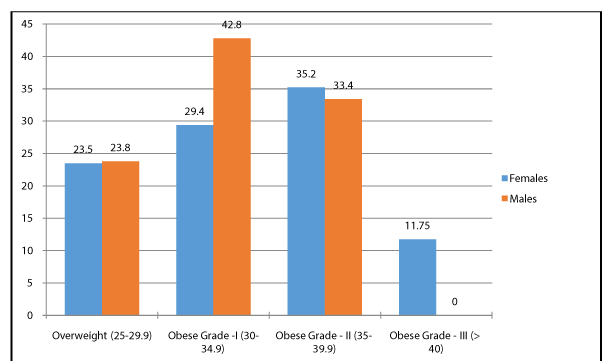
Biochemical analysis– estimation of Fasting blood sugar (FBS) level and Postprandial blood sugar (PBS) level.
- Diet recall– 24-hour recall method was employed for the assessment of the diet pattern of all the participants.
The diet intervention was given to every participant having complex carbohydrates, low glycemic index foods and moderate protein. This diet was administered to subjects for the duration of 12 months with regular counselling and follow-ups.
The results showed that there was a significant weight loss of 6% achieved in the span of 3 months as shown below.
Table 1: Initial and Final weight of the subjects in 3 months with the administration of Possible’s weight loss plan
| Parameters | Males | Females | ||
| Initial | Final | Initial | Final | |
| Weight (kg) | 105.2 | 98.7 | 80.7 | 75.4 |
Similarly, the blood glucose profile showed improvement in the Fasting and postprandial phase due to fibre and bioactive-rich compounds present in the Possible diabetic program. The systematic representation of the Blood glucose profile is shown in Figure 2.

Figure 2: Pre and Post Fasting Blood Sugar and Postprandial Blood Sugar level with Possible’s weight loss plan
The magic doesn’t lie in the medication or following any specific path for treatment. It lies in being aware of the disorder, its timely diagnosis, and efficient management.
To manage diabetes better, certified nutritionists of Possible recommend our own FSSAI tested food products that are high in fibre and protein. Our clients are a testimony to how effective these products are when it comes to lowering the blood glucose level.
Here are the list of products recommended by our health experts.
-
Trufiber
A combination of soluble and insoluble fiber, Trufiber is made of fenugreek, cumin seeds, psyllium husk, fennel and basil seeds.
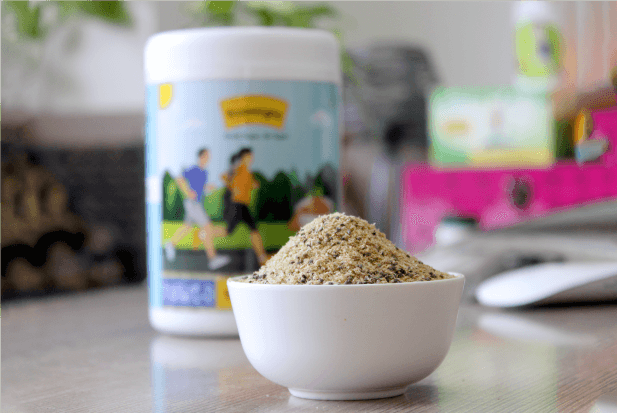
What are soluble and insoluble fibres?
Soluble fiber- This type of fiber dissolves in water to form a gel-like material. It can help lower blood cholesterol and glucose levels. Soluble fiber is found in oats, peas, beans, apples, citrus fruits, carrots, barley and psyllium.
Insoluble fiber- This type of fiber promotes the movement of material through your digestive system and increases stool bulk, so it can be of benefit to those who struggle with constipation or irregular stools. Whole-wheat flour, wheat bran, nuts, beans and vegetables such as cauliflower, green beans and potatoes are good sources of insoluble fiber.
-
Mighty Millet Idli
Millets are prescribed frequently by diabetologists quite simply because they are particularly known to bolster diabetes management measures. The high fiber content in millet is responsible for slowing down the release of sugar in the bloodstream.
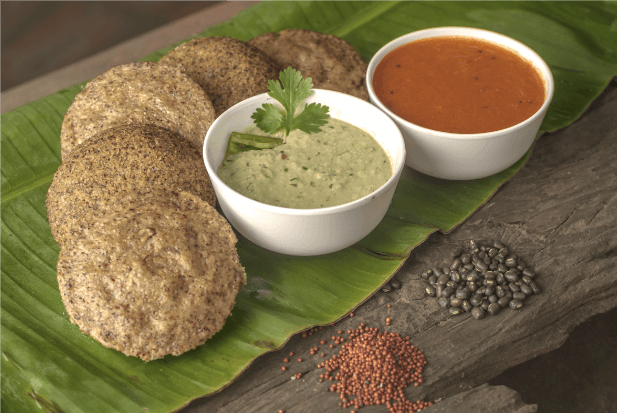
In fact, it would be more appropriate to claim that it slows down digestion – which results in the distribution of sugar at a more even pace.
-
Seeds cocktail
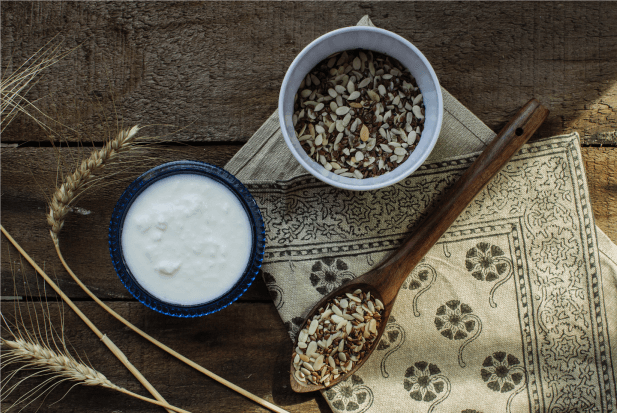
Nuts and seeds are also some of the best sources for magnesium, which is an important mineral in regulating blood glucose levels for diabetics and those at risk of developing type 2 diabetes. It can also lower bad cholesterol and risk of heart diseases.
-
Shake a day
This unique combination of protein and fibre would be a great energy drink for Diabetes.
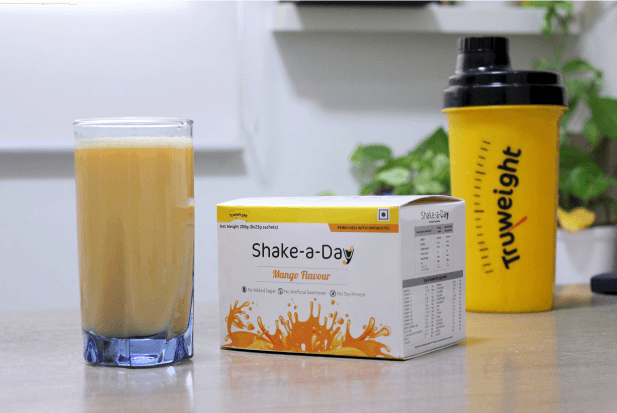
Since it does not impact blood glucose levels and also helps to sustain sweet cravings which are common among diabetic patients.
-
Jambu Gymenuma
This is a well researched ayurvedic herb which helps in controlling elevated blood sugar levels without any side effects.
It is a combination of Jamun seeds and gymenuma leaves both of which help in the stimulation of insulin secretion from the pancreas and stimulating pancreatic cell growth.
-
Chia Buckwheat Cookies
Buckwheat- This ‘grain’ actually comes from a fruit seed making it an ideal food for those with gluten sensitivities and diabetes.
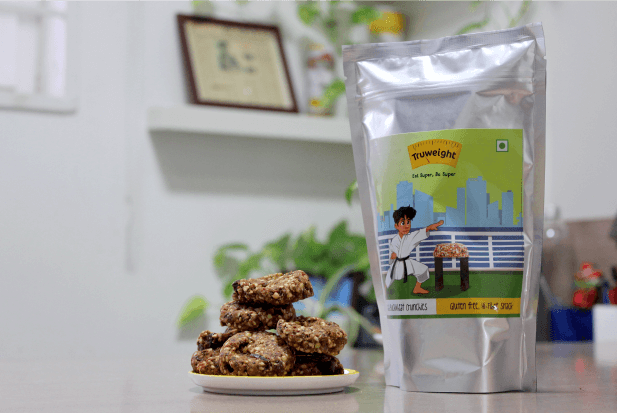
Research findings have shown that buckwheat can actually lower blood sugar levels. Buckwheat is high in magnesium, phytonutrients, and dietary fiber.
Chia- The omega-3 fatty acids and antioxidants in chia are very healthy. However, it is best known for its fibre content. Chia seeds seem to slow glucose passage into the blood. They keep the stomach fuller for a longer period of time and reduce the appetite.
-
Teatox-D
Teatox-D is a refreshing and delicious herbal tea, especially for diabetics. The powder made using Gymnema, amla and cinnamon are healthy and works efficiently for diabetic management.
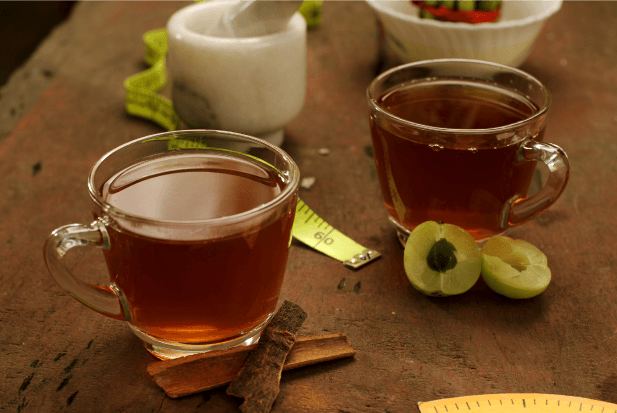
It possesses distinct property as sugar destroyer due to the presence of phytochemicals like triterpenes, saponins and polypeptide which are responsible for sweet suppression activity.
The magic doesn’t lie in the medication or following any specific path for treatment. It lies in being aware of the disorder, its timely diagnosis, and efficient management.
Success Stories
Dr Rakesh, an Orthopaedic surgeon, was quite worried about his diabetic condition and had an HbA1C level of 7.5. He was utterly stressed and in an unfit condition. In his wife’s own words, Rakesh was plagued by fatigue, especially during vacations.
Being doctors themselves, Dr. Rakesh and his wife knew the importance of avoiding regular and long-term medications and this is when they came to Possible looking for a solution.
Rakesh who had been to several weight loss programs in the past was initially sceptical about Possible since none of the earlier programs yielded the desired results.
Nevertheless, he enrolled in our programs and followed it diligently. And what followed was a dream come true for Dr Rakesh and his family.
Rakesh solely attributed his success to food and diet plan that was prescribed by Possible’s nutritionists. Out of Possible’s superfoods, Nuts Muesli, Millet Idli, Quinoa Dal Dosa and Trufibre are his personal favorites.
By eating the right food and following Possible’s advice, Rakesh was not able to control diabetes but also overcame fatigue.
Like Rakesh, another client of ours also realised her dream with Possible.
Divya Iyer, a chemist by profession, was a pre-diabetic when she first visited Possible and her HbA1C levels were quite high. At that time, she was suffering from varicose vein and knee pain postpartum and on top of this, her HDL levels were low and she had severe vitamin D deficiency.
It was not only the excess weight that was plaguing Divya but also a horde of health issues related to being overweight. In the past, she had taken a number of weight loss programs and therapies but to avail.
After her success with Possible, Divya could not stop praising Possible for its realistic and scientific approach towards weight loss. According to her, the well-researched range of nutritious and tasty superfoods and a personal dietician who can tailor the diet plan according to the client is the best thing about this entire program.
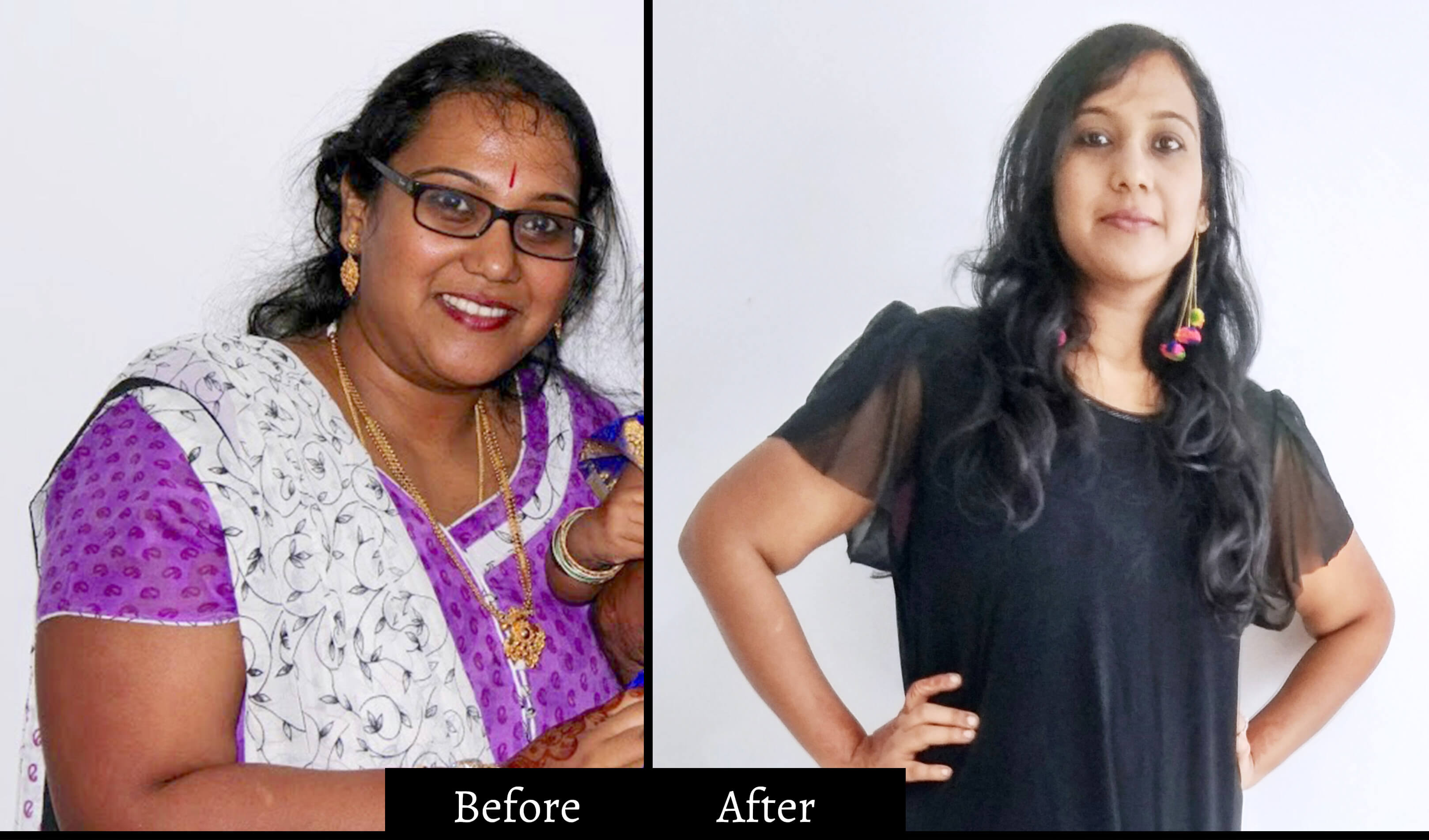
Possible helped Divya understand her body and its needs. After joining Possible, she realised that she was consuming unhealthy and nutrient-deficient foods for decades. Nutrient-dense superfoods provided by Possible helped her come a long way.
With the help of our superfoods, well-trained nutritionists and dieticians, Divya lost a staggering weight of 32.90 kgs in 14 months.
**Disclaimer: The testimonials mentioned above are based on each individual’s experience and results may vary for different individuals.
The real meaning of diabetes management lies in incorporating healthy habits for better management of the disease along with the health of family and future generations.
FAQs
Q: What foods to avoid with diabetes?
A: Diabetic patients should avoid foods that are high in sugar and simple carbohydrates.Q: Can hereditary diabetes be prevented?
A: Yes, hereditary diabetes can be prevented if you eat healthy foods and exercise regularly.Q: How to avoid diabetes in the early stages?
A: If you are a pre-diabetic, it is crucial to consult a diabetologist and switch to a diabetic-friendly diet. It is also very important to indulge in physical exercises. This will prevent the condition from turning into a full-blown Type 2 Diabetes.
Q: Are bananas good for a diabetic?
A: Since bananas contain fibre, vitamins and minerals, eating them can benefit diabetic patients. However, they should eat it in moderation.
Q: Can a diabetic patient eat rice?
A: For better sugar control, diabetic patients must avoid rice. Instead, they can eat brown rice or millets.
Embrace a healthy diet plan as it is the best way to keep your blood glucose under control and prevent complications.
Stay healthy, fit and diabetes-free! Cheers!

i want to know whether person who is suffering from diabetes can eat banana?
Dear Shashi! Yes you can have bananas, Requesting you to kindly refer this link also https://truweight.in/blog/health/fruits-to-control-your-diabetes.html
Nice blog… 🙂 full of information
Thanks, Truweight
Dear Vishal! We’re happy to receive your compliments and appreciation towards our article. Thanks for taking the time to share your prestige opinion on our blog, Keep following our blog to know such more health information.